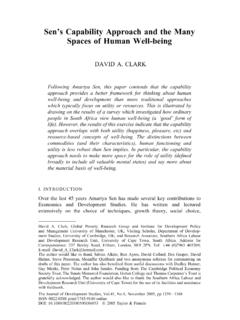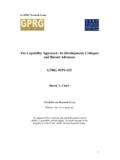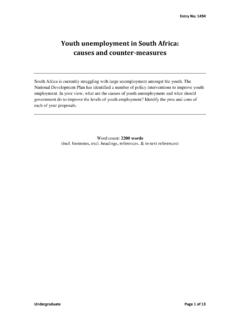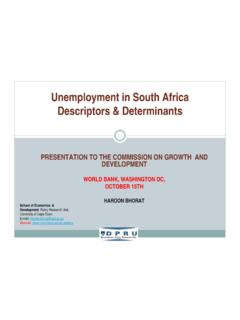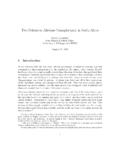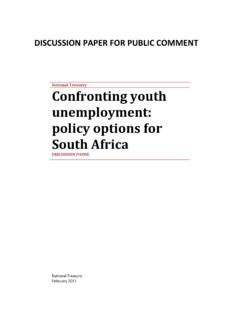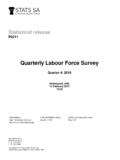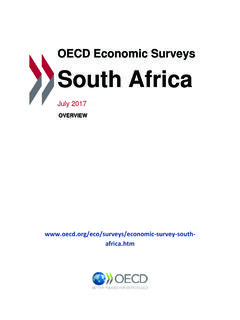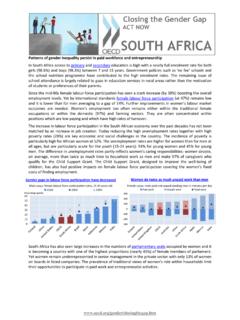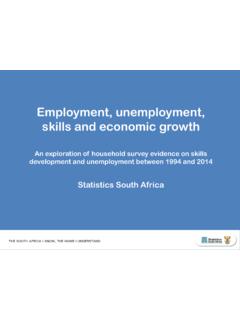Transcription of Unemployment in South Africa, 1995-1003: Causes …
1 An ESRC Research Group Unemployment in South africa , 1995-2003: Causes , problems and policies GPRG-WPS-010 Geeta Kingdon and John Knight Global Poverty Research Group Website: support of the Economic and Social Research Council (ESRC) is gratefully acknowledged. The work was part of the programme of the ESRC Global Poverty Research Group. 1 Unemployment in South africa , 1995-2003: Causes , Problems and Policies by Geeta Kingdon Centre for the Study of African Economies University of Oxford and John Knight Department of Economics University of Oxford January 2005 Acknowledgments: We are grateful to Haroon Bhorat, Daniela Casale, Dori Posel and Stephan Klasen for comments on this paper.
2 Geeta Kingdon s time on this research work was funded by an ESRC grant under the Global Poverty Research Group at the Centre for the Study of African Economies. The research was originally commissioned by the National Institute for Economic Policy in South africa . The views and opinions expressed are those of the authors alone. Our website is: , and the link to Unemployment in South africa : A microeconomic approach . 2 Unemployment in South africa , 1995-2003: Causes , Problems and Policies By Geeta Kingdon and John Knight 1. Introduction It is our view that developments in the labour market hold the key to South African prosperity or penury.
3 It is from the labour market that the income benefits from growing labour scarcity, or the threat to social and political stability from growing Unemployment and underemployment, could emerge. The government response should be to keep this issue at the forefront and to pursue whatever policies will improve labour market outcomes. Our primary concern in this paper is with Unemployment and the informal employment that often disguises Unemployment . However, in order to understand these phenomena it is necessary to consider a range of related indicators such as the adult population, the labour force, labour force participation, employment, distinguishing here between formal and informal employment, or between wage- and self-employment, and real wages and incomes.
4 Labour market data in South africa are not without problems. Data collected in the early post-apartheid period are problematic for various reasons such as differing sampling, non-coverage of former homelands in some surveys, small samples, Moreover, comparability over time is undermined both by changing questions between the various surveys particularly as between the October Household Surveys (OHS) and Labour Force Survey (LFS), and by changes in the way employment and Unemployment are derived from the questions in the different surveys (Casale and Posel, 2002). The definition of the informal sector also changed in 1997.
5 Further, population estimates change at every census so that when the weights are revised in each 5 year period, recent statistics require re-estimation with the revised weights, though such revisions usually make only relatively minor differences in most statistics. Lastly, labour market data display some inexplicable large fluctuations - for instance employment figures rise sharply (by ) in a single year between 1998 and 1999, employment in subsistence agriculture rose and dipped over 1999-2001 and there are large fluctuations from year to year in the numbers employed in the informal sector on a comparable definition between 1997 and 20022.
6 It is, thus, hazardous to make categorical statements about labour market changes over time in South africa . This hazard is somewhat reduced if one takes a longer term view than to look at year-on-year changes. This is what we do below. Nevertheless, our presentation is intended not to be seen as an accurate reflection of specific labour market numbers but rather as a description of broad labour market trends. We use mostly the October Household Survey 1995 (OHS95) and the Labour Force Survey, September 2003 (LFS03). In its starkest terms, the issue is depicted in Table 1.
7 The problem is that the economy is unable to absorb productively all the current labour force or all the increment to the labour force. In the near-decade after the advent of democracy (1995-2003), the (narrow) labour force grew by million and the broad labour force by million (both by over 5 % per 1 Klasen and Woolard, 2000; Casale and Posel, 2002. 2 See Bhorat, 2003, ; Altman, 2002, p6; and Devey, Skinner and Valodia (2003). 3 annum). By contrast, over the same period, wage employment rose by only million ( % per annum), self-employment grew by million ( % per annum), and narrow and broad Unemployment grew by and million respectively (both above 9 % per annum).
8 Over that period the Unemployment rate rose from 17 to 28% on the narrow definition and from 29 to 42% on the broad definition. South africa now has one of the highest rates of Unemployment in the world even on the official narrow (but potentially misleading) definition. Informal sector employment also grew to absorb some of the increased labour force. Table 1 Summary of labour market outcomes, 1995-2003 1995 OHS 2003 LFS Change (000) Change (% ) Labour Force, narrow (000) 11628 16192 4564 Labour Force, broad (000) 13667 19954 6287 Wage employment (000) 8231 9509 1278 Self employment (000) 1421 2111 690 Unemployment , narrow (000) 1976 4570 2584 Unemployment , broad (000) 4015 8332 4317 Unemployment rate, narrow (%) 17 28 11 - Unemployment rate, broad (%)
9 29 42 13 - Real earnings in wage employment, 2000 prices 3191 2805 -386 Real earnings in self employment, 2000 prices 6866 2610 -4256 Source: Tables 6 and 7 below. The growing divergence between labour supply and demand inevitably had a depressing effect on market-determined real wages. However, the wage sector, and in particular the formal wage sector, was relatively protected, so pushing the burden of adjustment onto the self-employment sector, especially that part of it which had relatively free entry. Whereas real wages fell by % per annum (and formal sector real wages by % per annum over the period 1997-2003), self-employment incomes fell dramatically in real terms, by % per annum (and informal sector real wages by % per annum over those six years).
10 The growth of large parts of this sector with underemployed people eking out a living - is a sign of labour market failure rather than of success. The theoretical framework for economists to bear in mind is shown in Figure 1. On the vertical axis is the wage rate (wf and wi for the formal and informal sector respectively), and on the horizontal axis is the labour force, L L , assumed to be constant. The curve MPLf shows the demand curve, based on the marginal product of labour, in the formal sector. The curve MPLi, measured from the right hand origin, shows the marginal product of labour in the informal sector.
